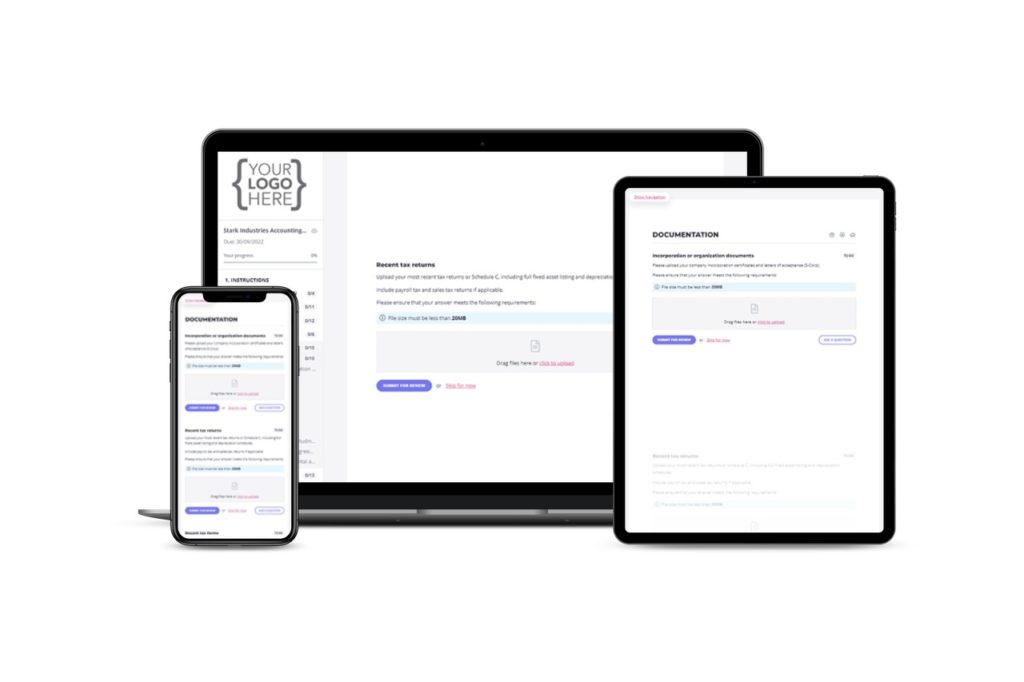In the digital world, content is king. It’s how businesses connect with new and existing customers, spread the word, and build hype. But content is a crowded market. Each day, over six million blog posts are published worldwide. And blogs are just one aspect of content marketing.
To stand out in such a crowded space, your clients need you to deliver content that’s engaging, insightful, and interesting. But more than that, you need to deliver content that meets your client’s specific needs and goals.
So how do you do that? One of the simplest, most effective ways is through a well-crafted content request form. In this article, we’ll explain:
- What a content request form is — and why you need to use one
- The questions you should be asking on your content request form
- The best way to client information

So what exactly is a content request form?
A content request form is essentially a survey or questionnaire. Its job is to provide you with a deep understanding of your client’s needs before you start working on a project, allowing you to deliver content that:
- Stays true to your client’s brand and tone of voice
- Resonates with their target audience
- Meets their specific technical requirements
- Achieves their goals
Content request forms can also be used internally. If you’re part of a busy marketing department, you may get content requests from your colleagues in sales, product, or HR.
Why do I need a content request form?
Imagine you’re a hairdresser. A customer comes in and says, “I’d like a haircut, please.” You proceed to cut their hair. Half an hour later, you’ve finished. But your customer isn’t happy. They’re devastated. “What have you done to my hair!” they shout.
From your side, it’s all a bit confusing. They asked for a haircut, and you gave them one. Why are they so upset? The truth is that when we ask someone to cut our hair, we have a specific idea in our mind of how we want it to look. The same goes when someone asks you to write a blog article, or create a short video.
Clear communication is essential. Without it, you and your client won’t be aligned on expectations, outcomes, and the scope of a project. With it, nothing is stopping you from nailing the brief. This can have a hugely positive knock-on effect on your business, including:
- Better client relationships — and an improved chance of repeat work
- Saved time — no more hours wasted in pointless meetings or endless back and forth messages
- The ability to consistently meet deadlines

Can’t I just use a marketing request form?
Marketing project request forms can be very generalised. They are designed to capture requests for any kind of marketing, including:
- Product marketing
- Social media and influencer marketing
- Visual marketing and advertising
- Marketing and brand strategy
- Marketing analytics
- Content marketing
All of these disciplines are different. They all have their own challenges, specifications, and goals. If your client has a content request, only a dedicated content request form will allow you to ask the right questions. This will save your client’s time too, ensuring they only answer questions that are highly relevant to their needs.
What questions should I be asking in a content request form?
Now that we know why you need a content request form, it’s time to discuss how to prepare one. In this section, we’ll run through the key questions you should be asking clients. We’ll cover key information about their business, brand, and the specifics of the project.
About your business
If a content request comes in from an external client, you need to find out who they are. Every business has its own challenges, goals, and target audience. Understanding what makes your client unique will help you understand their content marketing requests. Below are some important questions to ask. Of course, you can skip this part if you are dealing with an internal content request.
- What is your company’s name?
- What product or service do you offer?
- What customer problems do these products or services solve?
- What is your primary value proposition?
- Who is your target audience?
- What is your website URL?

About your brand
Every brand is unique. To deliver effective content that reflects a company’s personality and style, you’ll need a deep understanding of its brand. The following questions will help you get all the necessary details you need about your client’s brand and tone of voice:
- What five words would you use to describe your brand?
- What differentiates your brand from your competitors?
- Do you have a style guide or brand guidelines?
- How would you describe your brand tone of voice?
- What emotions do you want people to feel when they view your content?
- Could you describe your ideal customer?

About this content request
Content covers a broad range of outputs. A blog post requires completely different considerations to a video, for example. The questions here will help you narrow down exactly what your client needs, how to present it, and who it is for.
- What type of content do you need? (Blog post, e-book, white paper, social post, video, podcast, etc.)
- Please describe the project in as much detail as possible
- What is the aim of the content? For example, do you want to raise awareness, generate leads, convert sales, or create hype?
- Who is the target audience?
- Do you have any existing marketing materials or resources to support this request?
- Where and when will the content be posted?
- How will people find this content? Will it be promoted on social channels, via paid ads, or will people find it organically?
- Do you need help promoting this content?
- What would success look like for this project?
- What metrics would you use to measure success?
Technical specifications
This is where we dig into the technical details of the content request. The questions you ask here will depend on the type of content your client needs. Video content has different technical considerations to a blog post. Here are a few basic examples to get you started:
- Is there a word count or character limit for this content?
- Are there any SEO keywords you want to target?
- Do you need help with SEO keyword research?
- Do you have — or do you need help sourcing — any images, graphics, or video?
- Do you have any formatting requirements?
- Do you have any other technical requirements?

How should I gather the information I need?
We’ve discussed the types of questions you should be asking. but that’s just one part of the equation. How you go about gathering that information is also critical.
Many businesses use tools designed for information sharing, such as email, spreadsheets, or shared docs. But one way or another, these systems fail to offer the slick, hassle-free experience you and your clients expect.
Email threads can be a nightmare to sift through, running the risk that attachments get lost altogether. Spreadsheets are fine for managing and analysing large data sets, but they aren’t a great look for marketing agencies or teams. Shared docs can soon become messy.
Even dedicated survey tools like Google Forms don’t quite hit the mark. Instead of being able to work through the form as it suits them, users have to complete it in one go. What’s more, you’d need to use a different tool to ask follow-up questions or request further information.
Instead, you need a system for collecting information that:
- Is fully customisable to your needs
- Provides a slick and intuitive user experience
- Allows you to manage all aspects of information collection in one place
- Streamlines communication between you and your clients
- Saves you countless hours searching for lost attachments or conversations
In other words, you need Content Snare.
How Content Snare makes it easier to collect information
Content Snare takes the hassle out of collecting client information. Instead of using messy email threads, spreadsheets, or shared docs, you have everything you need in one place, allowing you to:
- Easily create and share custom surveys and questionnaire
- Request, approve, and reject client information without email
- Use one of a growing number of ready-made templates
- Answer client questions and provide support
- Set up automatic reminders
- Gain a 360-degree view of progress via our dashboard
Content Snare saves you countless hours spent searching for lost attachments, chasing clients for information, or sitting through avoidable follow-up meetings. You’ll make your clients’ lives easier too. And as we all know, happy clients tend to be loyal clients.




